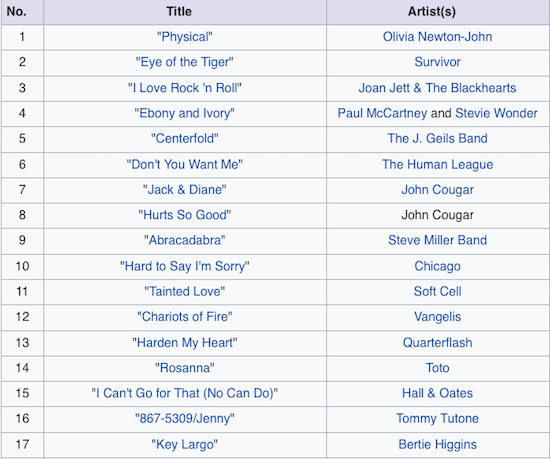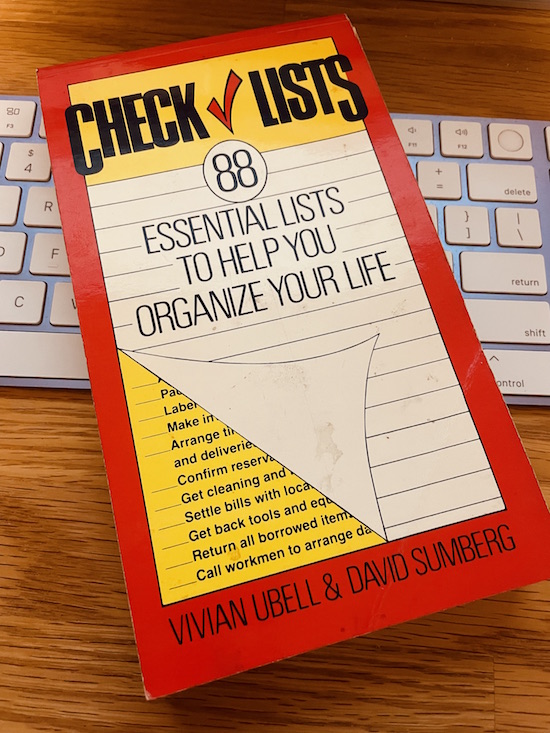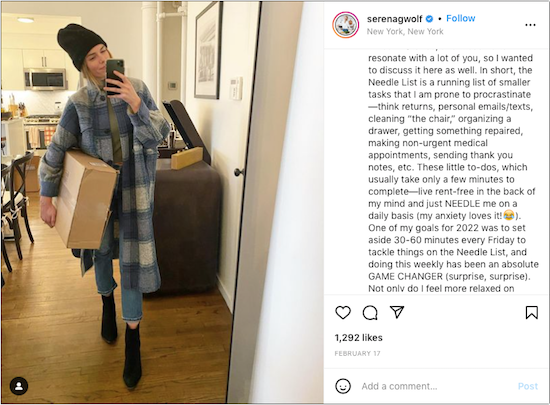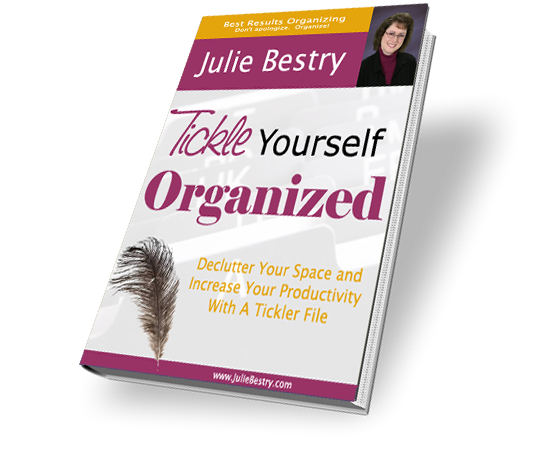Follow Me
Latest Posts
- Cool, Sustainable Packing and Shipping Solutions for Earth Day
- Paper Doll Shares How To Select a Shredder, Shred Responsibly, and Save
- Paper Doll’s Ultimate Guide to Tax-Smart Organizing: 2024
- Paper Doll Explains Aspirational vs. Inspirational Clutter
- Paper Doll Shares 3 Quirky & Cool New Office Supplies
Search Best Results Organizing
Subscribe to the Paper Doll Blog via Email
Paper Doll on the Magic of Making Lists
Posted on: April 11th, 2022 by Julie Bestry | 21 Comments

THE APPEAL OF A LIST
Paper Doll is a sucker for lists.
My childhood diaries (y’know the kind, pink with a lock that could easily be opened by a bobby pin) were just page after page of my mini-me wishes and hopes.
One of the first organizing-related books I ever purchased (when I was still in high school, back when dinosaurs roamed the earth and the top song on the Billboard charts

was Olivia Newton-John’s Physical), which still sits on my bookshelf, was Checklists: 88 Essential Lists to Help You Organize Your Life. It contains a wide variety of lists my 15-year-old self assumed would be, as the book title indicated, essential for becoming an adult.
Many of the lists were, and still are, useful. The “What To Do” checklists started with life transitions like how to find a roommate, plan a wedding, prepare for having a baby (or adopting one), buy a new or used car, or get ready for a move. These continued on through less happy events, like what to do if you’re going through a separation or a divorce, are a victim of a burglary, have to stay in the hospital, or need to plan funeral arrangements.

I will grant you that many of these step-by-step To Do lists, such as how to apply to college or for a mortgage are outdated these forty (gasp!) years later, and I can’t say I ever found the lists for buying a summer home or putting my boat in the water particularly useful. Oh, but the aspirational aspect of it all!
The other sections of the book were equally magical, with checklists for packing (for everything from a day at the beach to — I kid you not — sending your child to boarding school) to hosting social events (from children’s birthday parties to showers to Christmas dinners and Passover seders). And even after 20 years as a professional organizer, I still take a gander at the “What to Have” checklists for organizing every space from tool boxes and medicine chests to linen closets and garden sheds.
Even last week, when I was perusing the new books shelves at my public library, I couldn’t bring myself to bypass 52 Ways to Walk: The Surprising Science of Walking for Wellness and Joy, One Week at a Time.

It’s not that I don’t know how to walk; I get my 10,000 steps every day. But I was captivated by a portion of the introduction, where author Annabel Streets (yes, a book on walking by someone named Streets!) writes:
Nor is walking merely step-counting or “exercise.” Yes, good physical and mental health are happy by-products. But the joys of walking are infinitely greater than clocking up steps. Think of it as a means of unraveling towns and cities, of connecting with nature, of bonding with our dogs, of fostering friendships of finding faith and freedom, of giving the finger to air-polluting traffic of nurturing our sense of smell, of satisfying our cravings for starlight and darkness, of helping us appreciate the exquisitely complicated and beautiful world we inhabit.
However, had the title on the spine not seemed like a ready-made list, I’d surely have moved on without it.
The world has been conspiring to put lists on my mind even more than usual lately, and if you don’t mind the presumption, I’d like to share some of the thoughts I’ve had regarding list-making.
USE LISTS TO SET (AND MAINTAIN) BOUNDARIES
Last Thursday, I was reading James Clear‘s weekly newsletter. If you’re not familiar with Clear, I encourage you to read his excellent Atomic Habits: An Easy & Proven Way to Build Good Habits & Break Bad Ones.

While I’m careful to keep my inbox lean, I confess that I subscribe to many (perhaps too many) newsletters for inspiration for this blog and to find resources for my clients. Some are on organizing and productivity; others are financial. I enjoy many of the AARP newsletters, particularly Sisters from AARP, which celebrates and offers wisdom for Black women. And though they profess to be about mindfulness, mental health, and positive psychology, I realize that many of the newsletters are written for millennials and Gen Z. I’m voracious.
Clear’s 3-2-1 Newsletter avoids any and all of the excesses many of my other newsletters display; his is pared down to the essentials: three wise (tweetable) quotes from Clear himself, two quotes from others, and one question for the week. (Last week’s remarkable question, “What is a small but courageous choice you can make today?” has floated through my head for days.)
A short “list” itself, the newsletter is what I, in all my years of blogging, can never aspire to: brevity. But I do not begrudge Clear’s success because you, my dear readers, are often the benefactors of the concepts he shares. Last week, he linked to a tweet by Jenée Desmond-Harris, a writer, editorialist, editor, and the current Dear Prudence for Slate.
I started dividing my to-do list into 1) things I have to do, 2) things I want to do, and 3) things other people want me to do. Life changing! I often don’t get to 3 and I finally realized omg, is this what it means to have boundaries?! ???
— Jenée (@jdesmondharris) June 26, 2021
I loved this tweet. First, I always try to teach my clients that when they’re overwhelmed and overburdened by a To Do list that is more a Could Do list, they need to check to make sure what they’re doing brings them closer to their goals.
When you're overwhelmed and overburdened by a To Do list that is more a *Could* Do list, check to make sure what you're doing brings you closer to your goals. Click To TweetAnd I’m sure you’ve heard me say that, more important than SMART goals (which are specific, measurable, attainable, relevant, and time-specific) are SMARTY goals, where they Y represents values and ideals that are YOURS.

If you are constantly laboring toward goals that are not your own, but are your spouse’s, your parents’, or society’s, you will eventually come to resent the labor and the sense of obligation, and likely passive-aggressively (or just aggressively) rebel, possibly without even realizing it, but to your detriment.
Second, I appreciated this tweet because it dovetails nicely with a quote from one my colleagues. Four of my veteran professional organizing colleagues — Maria White, Yve Irish, Karen Sprinkle, and Nancy Haworth — and I are in a mastermind group. To help us achieve our goals, we start each week sharing our intentions; at the end of the week, we report back on how well we’ve done, and discuss our obstacles (and whether they’ve been internal or external).
Yve, famous for her enthusiastic Memojis when sending cheerleading texts, replied to one of my weekly emails with, “Woohoo Julie! Two great organizing sessions and they both booked follow-ups! I think you got all of the important things done. Much of the not-dones are items from someone else’s To Do list.”
Until then, I’d been feeling a little down about not having achieved everything in my (admittedly overambitious) list. But Yve was right. The things I hadn’t completed had not been, in the words of Jenée Desmond-Harris, things I had to do or things I wanted to do.
They were things someone else wanted from me, tasks for which I had not obligated myself. Without recognizing I’d done it, I’d practiced that mantra found photocopied and posted on assistants’ desks nationwide: “Lack of preparation on your part does not constitute an emergency on my part.”

I was focusing on the important and urgent tasks on my own To Do lists. I was guarding my own boundaries.
When we make our To Do lists, perhaps we should consider dividing them into these categories, what we must do and what we want to do, and put the oxygen masks over our own noses and mouths first before attending to others (tiny humans notwithstanding).
USE LISTS TO DECIDE WHAT YOU WANT FROM LIFE
Desmond-Harris, as well as my colleague Yve, got me thinking about the kinds of lists we create. We all have task lists, those To Do items, whether analog or digital, that get us through our days or weeks. At the micro level, these lists help us achieve our smaller, more discrete goals.
But what about our big ticket goals? Do you keep lists of those?
I went back to the post I wrote at the start of this year, Review & Renew for 2022: Resolutions, Goals, and Words of the Year to think about goals and visions. I found plenty of lists there, including Gretchen Rubin’s list of 21 things she’d wanted to do in 2021. Of course, she’s got a 22 in 2022.
When I got to the end of the post, I saw I’d linked to Jack Canfield‘s post on creating vision boards. About 16 or 17 years ago, Jack Canfield (of the Chicken Soup for the Soul books) was a guest speaker at a NAPO Conference. He’d just authored The Success Principles: How to Get From Where You Are to Where You Want to Be, and everyone heading to conference was buzzing about it.

It’s been enough years (I was still in my thirties!) that you’d think the book would not have had such a hold on me, but the “assignment” on page 28 has held a fascination for me ever since.
In the chapter “Decide What You Want,” Canfield suggests readers make an “I Want” list and delineate 30 things you want to do, thirty things you want to have, and thirty things you want to be — before you die.
Readers, I went to an Ivy League college. I have a Master’s degree. I started my own business. But I have to tell you, writing out these three lists was the most difficult intellectual experience of my life. I’ve carried this folded-up list in my daily planner all of these years, taking it out with some frequency, and occasionally adding something new or checking off an accomplishment. My inability to complete the lists sometimes makes me wonder if I need a therapist or a life coach!
I only managed to come up with 11 things I wanted to do, of which I’ve done three (including finally reading Anna Karenina last year); and though I got to check off visiting the UK, the most exciting things I’ve done since creating the list, visiting Italy and publishing my book, didn’t even make the list! My imagination was too confined!
Similarly, my list of (tangible and intangible) things I wanted to have only made it to item 15. I’ve only acquired three, but those three (including my little, red Kia Soul) give me joy each day. And my shortest list, of things I wanted to be, only reached eight items, of which I’ve only achieved one.
And yet, I’m happy with my life and with my lists. The things we want at any given time help shape the choices we make; but the choices we make can shape what we want next.
The things we want at any given time help shape the choices we make; but the choices we make can shape what we want next. Click To TweetSometimes, our lists (like the ones in my elementary school diary) may seem silly in retrospect; others show us how far we’ve come.
What would you put on Jack Canfield’s lists? What are:
- 30 things you want to do?
- 30 things you want to have?
- 30 things you want to be?
DO YOU NEED A NEEDLE LIST?
About a month ago, the Huffington Post published a piece by Kelsey Borresen called Want to Declutter Your Brain? Cross Something Off Your Needle List. I read it within a day or two of publication, agreed with the general gist, and went on about my life, not having given it much thought. Since then, there hasn’t been a day when it hasn’t shown up in one of those many newsletters to which I subscribe or appeared in my Twitter feed.
The article is needling me!
It’s easy to see why. I encourage you to read it in full, but the basic concept is that we all have these things on our To Do lists that we fail, repeatedly, to do. Usually, they aren’t huge projects, but fairly simple tasks that we avoid, over and over. And yet we cross them off today’s task list and dutifully put them on tomorrow’s, where they will fail to be attended to for several days (or weeks) hence. And they’ll continue to needle us.
Quoting an Instagram post of chef/author Serena Wolf, who coined the term, Needle Lists are filled with the small tasks that create that hum of low-level anxiety as we continue to fail to accomplish them.
It’s the donation bags in our trunk (or worse, blocking the front hall) that haven’t been taken to charity. It’s the sink that’s full of dishes because the dishwasher of clean dishes hasn’t been unloaded. It’s the thank you notes that have gone unmailed (or unwritten). And for the past two weeks, for me, it was the oil change that I planned to get each day, but by the time everything else got accomplished, my mechanic had closed for the evening.

Wolf’s plan, simple but a bit of genius, was to set aside 30-60 minutes each Friday to tackle items on her Needle List. She notes, “Not only do I feel more relaxed on weekends, but it also makes me more productive during the week because I find it easier to focus with less mental clutter. The batching mentality also helps relieve any stress/anxiety when a new Needle List item pops up because I can drop it into Friday’s brain basket.”
Happily, this goes along with advice I’ve shared about time-blocking, here:
Playing With Blocks: Success Strategies for Time Blocking Productivity
Paper Doll Shares Secrets from the Task Management & Time Blocking Summit 2022
Time blocking basics are key to the Needle List. Wolf has a place to collect these otherwise needling, cringe-provoking tasks.
She sidesteps the problem of there being no “Someday” on the calendar by scheduling these tasks for a fixed block, on Fridays. (For you, it might be a Saturday morning or a Monday afternoon or a Wednesday lunch hour.)
And she goes through her week confident that a task won’t fall through the cracks, so she can stop constantly reminding herself that there’s something undone.
If you’d like to try making a Needle List and time blocking a part of your week to address these things in a batch, I’d encourage you to use a tickler file to its best advantage.
Let’s say, like Wolf, you’re going to block Friday afternoons to stop things from needling you. Why not write yourself notes (so you’ll think about what you have to do, in a nuanced way, rather than just constantly thinking of what you will do) and collect them with receipts, items to mail, etc., in that Friday slot of the ticker file. Anything left incomplete this Friday gets moved to the next Friday opportunity; it’s no longer hanging over you; it’s been rescheduled!
THE POWER OF LISTS
- Lists can be organizational — they create structure and boundaries.
A shopping list ensures that you purchase what you need, and assuming you don’t go into Target (because it’s impossible to leave Target with just what’s on your shopping list) you won’t buy what you don’t need. Gift wish lists (including wedding registries) make it more likely that people won’t waste their money on things you don’t want or need, that won’t mesh with your values or fit your physique.
A To Do list helps you do a brain-dump of everything you know you must accomplish, and then create lists of tasks, whether in the order you intend to accomplish them or batched in groups so that you can take them from list-mode on paper (or in an app) to time-blocking mode on your calendar. And if your lists are divided, as Desmond-Harris suggests, into what you must do and what you want to do, leaving those things others want you to do for last (or never), safeguarding your boundaries, how many more of your big-ticket goals might you achieve?
A packing list, and other travel-related lists, can ensure that you consider your needs and wants without last-minute pressure. (Take Paper Doll’s 5 Essential Lists For Planning an International Vacation, for example.)
Lists of books we want to read, movies and television programs we want to watch, and places we’d like to visit create structure and boundaries without greatly limiting our options. When we’re faced with an Amazon or Netflix full of titles, lists of recommendations can keep us from wasting time surfing or making mediocre choices.
- Lists can relieve anxiety.
Trying to remember everything you need and want to do is exhausting. It’s also untenable. That’s where lists come in.
A well-done, properly-approached list can prune the stress out of your life. A massive list written on both sides of piece of paper, with items you need at the market combined with 5-year-plan types of projects without distinct tasks is not a well-done list.
Neither is anything scribbled on the back of an envelope, or on 63 sticky notes on every vertical and horizontal surface around you. Lists that live in all the different in-boxes of your life, in email and Asana and Evernote, in the notebook in your bag and the whiteboard in your office, are too likely to discombobulate you.
Some people swear by David Allen’s Getting Things Done, which, when followed closely, is a love letter to lists. I appreciate GTD and teach it to clients whose style it fits, but find elements of it to be overly complex.
Others swear by list-based bullet journaling, created by Ryder Carroll,
but which has long since taken on a life of its own, and which I (and many of my clients find intimidating in its modern form).
Personally, I’m a fan of the 1-2-3 list. I believe in the philosophy that if it won’t fit on a Post-it®, it won’t fit in your day, so I counsel overburdened clients to look through their master lists, brain dump lists, and inboxes, and for any given day, find one big task, two medium-sized tasks, and three small tasks which are their absolute must-do items for the day, the ones that if that’s all they complete, they’ll declare victory.
This is why, when I first teach clients how to use a tickler file (you have read my Tickle Yourself Organized, right?), I’m often discouraging them from piling too many things in any one day’s slot. I may write without brevity, but I coach others to embrace it!

- Lists can be aspirational.
As with Jack Canfield’s entries, not every list is designed to accomplish the things listed in that book I bought back in 1982. Yes, we need lists to tell us what to do, pack, and purchase. But for envisioning the possibilities in our life — and for reviewing with less embarrassment than reading our teenage journals — lists can help us imagine different lives.
Might you make a list of other careers you could have? Other cities (or countries) in which you might live? Other personal attributes you’d like to have, or habits you’d like to extinguish?
There are days (or years) where we feel boxed in, where it can be difficult to imagine a different “we” that we could be. Vision boards are highly touted for helping people imagine how (and as whom) else they might live. However, I’ve found that whenever I clip photos to create a vision board, they always end up being full of tall, lithe women with long ponytails, doing yoga with lush, green mountains in the background. Eventually, I learned that I don’t want to do yoga; I just want to be a tall, lithe woman with a long ponytail.
For me, vision boards don’t work for expanding my self-view, but lists do. Perhaps they will for you, too?
What lists are essential in your life? Please share in the comments!




Wow, Julie! This is some list of lists. I am a list maker. I love my lists. I have a ‘things to do this week’ list usually set behind a ‘things to do today’ list. I am now going to make a Needle list. I love that expression! There are definitely things I move from one day to the next. Typically they are small things I am avoiding – because I can. Having said that, they are things I want to take care of. The Needle list is the next one I am making! I also like the idea of making a list of 30 things I want to do, to have, to be.
Thanks for reading, Diane. There really is so much power in a list, and for years I’ve been thinking I need to talk about some of those powers — to organize, to reduce anxiety, and to inspire. If I’d had that goal on an actual list, maybe I’d have written about these things earlier. 😉
I appreciate that the Needle list is a form of time blocking with a very specific purpose. When I do time-blocking and daily themes, I always create a problem-solving block mid-week, but I’m definitely teaching them to add a Needle list from now on!
That’s a lot of list options. I love my lists! They help me stay focused and keep me moving forward. My favorite lists are my digital/paper time management planner list. This keeps me focused every single hour with the most meaningful activities. I use my paper planner exclusively if something comes up during the day. I jot things down and add them to the list. Just writing things down with a pen reminds me to do it.
I used to wonder how people without lists got things done. Eventually, I realized that for most people, they don’t! I love that you mention the importance of focus, as that dovetails with what I said about the structure lists give us. We don’t always abide (or even have to abide) by that kind of structure, but just having it available to us can make all the difference.
Did you know I couldn’t possibly pass up a blog post with the words “Magic” and “Lists” in it? 🙂
I use WorkFlowy for my Master List (which consists of all sorts of nested and categorized lists and checklists). And I did formerly use a Post-It for my daily tasks! (Tasks for that day, not daily-recurring tasks.) Lately I use a TO-DO “event” in my iPhone Calendar, deleting things as I complete them, and moving the whole “event” forward a day at a time with any remaining items. I try to keep it short (and, in any case, can adjust the amount of time it appears to take up on my calendar). If something would be better off scheduled in a time block “event” of its own, I do that. And if something lingers “too long” on this list I either reconsider and delete it, or realize it’s really a project and break it down in to smaller tasks, or move it to a non-urgent WorkFlowy list.
For tasks that need to be done daily, I’m using the Reminders app on my iPhone. I like that the items disappear as I check them off. And reappear again the next day.
I’m a fan of dedicating and naming time blocks for certain categories of tasks or projects (such as Needle List Friday). One of mine is Money Monday. There are any number of financial tasks that must be done — some regular, like paying bills, and some that pop up, like a call that must be made regarding an insurance question — that if I had to worry about them every day, as they arose, I would constantly be stressed. I like adding it to the “$$” list, and not having to worry about it until Money Monday.
I was a HUGE Workflowy user for many years, but got out of the habit as I realized that I just don’t have the same emotional and neurological connection to words I type (unless they’re part of a narrative).
I love Monday Monday, and I am also a fan of naming my time blocks, though I’m not as creative. Mine are Problem-Solving Wednesday, Marketing Money…and my financial day is Tuesday because there are too many Mondays where the banks are closed. But the theory is the same.
I’m facinated, and maybe horrified, that you delete things after you’ve completed them; I can’t even bring myself to cross something off a list and can only check items off. I have always felt the need to keep a detailed and complete record of everything of consequence that I’ve ever done. If I delete what I did, have I even done it? 😉
Ha! Regarding only the deletion of completed tasks (there are far more aspects of time management and list-making than we can cover in blog post comments, including circumstances in which I resort to handwriting!): Maybe it comes down to what we each consider “of consequence”. I can’t think of very many tasks that do not leave evidence of having been done. If I changed a light bulb, does it really matter when it was? Or that I did only 3 things yesterday and 12 the day before? Or, if I fed the cats? (Bad example, as REALLY routine things don’t make it to a list.) Most things — reply to an email for example, there’s a record of it. Or if the task was to proofread a presentation, there’s the presentation itself as evidence. If there’s a paper checklist of items pertaining to the presentation INCLUDING proofreading it, and I finish all the items, I can toss the checklist because I’m done. (After I check all the boxes AND cross them out!) On the other hand, I do have a list called “The Last Time I…” because I DO lose track of time when it comes to things I consider consequential. Was it five years since my last colonoscopy? Or six? When did I get that new roof? (Is it still under warranty?) Etc.
I make a LOT of phone calls, and there are no automatic records of those. I like to keep a careful record of each time I reach out, whether I left a voicemail, what I said, etc. It comes in handy. By the end of the day, more than half of my task items are the things I made calls about, which often trigger other calls — client calls, medical issues, financial tasks, etc.
Funnily enough, I would have easy-to-find records of any medical procedure, repair, etc. But either way, come January 17, 2045, I want to be able to identify what I did on April 12, 2022. Every bit of it. I want every detail of my human story. As said in Doctor Who, in the end, we’re all stories, so let’s make it a good one. 😉
“Every detail of my human story” reminds me of the 33 boxes of paper my mom left me to deal with. Regarding phone calls, though, I can’t talk on the phone without taking notes! If I’m asking about a bill, I’m writing on the bill itself. Even if it’s a personal call, I’m taking notes, or at least I’m prepared to in case something note-worthy comes up. Some of them I keep for a long time, but most of them I toss eventually.
If you figure out how to become the tall, thin woman with a ponytail, let me know LOL!
I love lists. Lists keep me sane. I have lists all over my life. Not only task lists, but lists of books to read, movies to watch, and fun things. I think of my Pinterest “Recipes to try” board as a visual list. I have a list of things to discuss with my husband, discuss with the yard guy, the painter, etc.
For tasks, I love your 3-2-1 idea. That really helps prioritize what should be done, while also keeping it realistic!
I don’t know, Seana, but if I master growing 6 inches, becoming bendy, and getting that luxurious mane, I’ll be sure to clue you in!
I appreciate the value of Pinterest as a visual list, but to be honest, after all these years, I only pin and never return to look at anything because I’m not visual. But lists? I see life as a series of lists; it’s how I make sense of the world.
You had me at “the Magic of Making Lists!” I LOVE making lists. Why? As you said, they get that stuff out of your brain and help you focus on the actions and ideas you want or aspire to do or become. The mere act of writing things down activates an awareness that put things in motion…even if you don’t schedule time to actually do those things.
My mom and I used to joke that our lists have lists. And sometimes I feel that way, especially when I’m in “deep list” mode with many projects happening at once.
I use a variety of lists from digital to paper. And amazingly, they all work beautifully together and serve their purpose. My electronic “2Do” app (list) cues me for tasks to do each day. Things are easily checked off or moved to another day if needed. They have short and long-term tasks. I use the same app for lists of Books to Read and Books Read.
When it comes to managing projects, I often will create a separate project task list as a Word doc that I print onto paper and keep with the project folder. I use my electronic “2Do” list to cue me to that project.
And let’s not forget post-it notes! I can’t decide if I love lists or post-it notes more. But it’s not necessary to decide. I love them both. As a matter of fact, I’m staring right now at a post-it note with the names of bloggers (from our group) that I want to comment on. And guess what? You’re on the list!
As always, I appreciate the depth you’ve shared here. Clearly, you are a list-lover too!
What could be better than a list on a Post-It® Note, Linda? I am, indeed, a list lover!
I wish I could embrace a digital list, but I find that there’s just no “stickiness” to anything digital. I read every tangible book I take out of the library, but forget 90% of the ebooks I borrow. I never look at my digital calendar, so unless I set a reminder, it’s meaningless to me. And I’ve given up on task apps. I guess I can’t take orders unless they appear in handwriting!
Thank you so much for taking the time to read and comment!
Oh wow! Your mention of a “could do” list was an ah moment for me. I started creating a project list every 3 months that focused on things I wanted/needed to do for my business. I then set tasks to remind me to start working on the next project. The problem was I kept skipping over projects for other things that I felt more compelled to do. I think my quarter list was more of a “that be nice to have” list.
I know exactly what you mean, Janet. I think we waste a lot of mental energy skipping, jumping, and hopping over those “could do” projects.
Lists are funny. For years, when I seemed upset or anxious, my partner would say, “Why don’t you try making a list?” It took him about a month of being around me to realize lists calm me down. Once whatever’s in my head is in a list, it feels more manageable.
Though my daily task lists are probably the main thing holding my business (probably life) together, now and then, I make a to-done list (dumb name, surprisingly effective). My brain weasels often tell me how lazy I am and when I realize that’s happening, I ditch the “stuff I need to do list” in favor of “stuff I’m getting done list.”
Throughout the day, I write down everything I do, even if it’s something as small as taking out the trash during a work break. It turns out that I do a whole bunch of stuff I routinely don’t give myself credit for doing. When I make a to-done list, I have written proof that the brain weasels are lying, so when they start chattering, I can just look at the list of things I spent my time doing that day.
It’s funny how much psychology is involved in making lists, isn’t it?
Lists make you feel like you have more control, or at least some control. Even if you’re making a list of things over which you have NO control, the list makes it all more compact.
I love that you’re making what is, essentially, a “why I rock” list! Darn-tootin’ that you should give yourself credit for all those things, brain weasels be damned!
I love your article. I’m also a list lover.
One of my favorite lists is the “lost” list. When I am missing or have misplaced something I add it to the list. I’ll check it off when I find the item and feel relieved and successful. I also encourage my friends and clients to use one on an ongoing basis.
Another list – like a “why I rock list” is the Accomplishment List. I add things to this list journal that have been completed over the years. It is where I listed in 12/99 – Palm Pilot user, 12/01 – 20th wedding anniversary, 7/10 drove Dad on 3500 mile road trip.
Thanks for writing this – I always enjoy your Paper Doll blog posts.
Oh, Terry, I love the idea of a “lost” list; whenever I can’t find something, I put it on my next day’s task list, and 99% of the time, I find it a minute later. But an umbrella lost list is a great idea; in fact, all these list ideas people are mentioning may mean I need to create a list of unusual lists for a future post. A list of lists!!!
And I often talk about a success folder — in files, on the computer, in email — so a “why I rock” is a fabulous idea!
Thanks so much for reading and interacting!
I use Todoist for pretty well all of my lists. It works well but there are some drawbacks – one being that it’s very easy to reschedule incomplete tasks to the next day or week, but that causes stress. I therefore love your idea of scheduling a block of time each week to deal with them.
Another issue is that putting personal projects I’d like to do on my task list feels like I “have to” do them instead of serving as a reminder of fun things I can do when I’m not working. Your post has so many wonderful ideas and resources that I have no doubt I can come up with a solution for that too.
I’m so glad you got some things to like out of this post, Janet!
Personally, digital task lists just don’t prompt me to do things. For whatever rhyme or reason, I can only successfully boss myself around in longhand! 😉